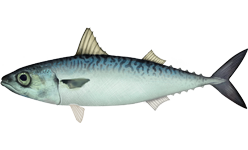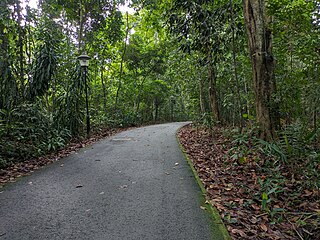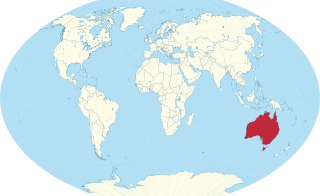
Spathodea is a genus in the plant family Bignoniaceae. The single species it contains, Spathodea campanulata, is commonly known as the African tulip tree. The tree grows between 7–25 m (23–82 ft) tall and is native to tropical dry forests of Africa. It has been nominated as among 100 of the "World's Worst" invaders.

The chub mackerel, Pacific mackerel, or Pacific chub mackerel is a species of fish in the tuna and mackerel family, Scombridae. This species of mackerel closely resembles the Atlantic chub mackerel.

The cabezon is a large species of sculpin native to the Pacific coast of North America. Although the genus name translates literally as "scorpion fish", true scorpionfish belong to the related family Scorpaenidae. The cabezon is the only known member of its genus.

Drosera intermedia, commonly known as the oblong-leaved sundew, spoonleaf sundew, or spatulate leaved sundew, is an insectivorous plant species belonging to the sundew genus. It is a temperate or tropical species native to Europe, southeastern Canada, the eastern half of the United States, Cuba, Hispaniola, and northern South America.

Trillium flexipes, known as the nodding wakerobin, bent trillium, or drooping trillium, is a species of flowering plant in the family Melanthiaceae. It is found from Minnesota to Ohio, south to Tennessee, with isolated populations in New York, Pennsylvania, Alabama, and other states. It is an endangered species in Ontario and threatened in North Carolina.

Trillium cuneatum, the little sweet betsy, also known as whip-poor-will flower, large toadshade, purple toadshade, and bloody butcher, is a species of flowering plant in the family Melanthiaceae. It is a member of the Trillium cuneatum complex, a subgroup of the sessile-flowered trilliums. It is native to the southeastern United States but is especially common in a region that extends from southern Kentucky through central Tennessee to northern Alabama. In its native habitat, this perennial plant flowers from early March to late April. It is the largest of the eastern sessile-flowered trilliums.

Lupinus perennis is a flowering plant in the family Fabaceae.

Trillium vaseyi, the sweet wakerobin or sweet beth, is a spring flowering perennial plant which is found only in the southeastern United States, primarily in the southern part of the Appalachian Mountains but with a few populations farther south.
Oryzias marmoratus, also known as the marmorated ricefish or marmorated medaka, is a species of fish in the family Adrianichthyidae, from Lake Towuti, Lake Mahalona, Lake Lontoa and associated streams in Sulawesi, Indonesia.

Hypericum canariense is a species of flowering plant in the family Hypericaceae known by the common name Canary Islands St. John's wort. It is the sole member of Hypericumsect. Webbia.

Lotus subbiflorus, the hairy bird's-foot trefoil, is a flowering plant of the pea family Fabaceae.

Pisolithus is a genus of fungi within the family Sclerodermataceae.

The marbled water monitor, also known commonly as the Philippine water monitor, is a large species of monitor lizard in the family Varanidae. The species is endemic to the Philippines.

Dairy Farm Nature Park is a 63-hectare nature park located at 100 Dairy Farm Road, Upper Bukit Timah in the west side of Singapore. Dairy Farm Nature Park is known as a recreational area that offers a variety of attractions for visitors to explore. Some of the more notable attraction of the park includes the Singapore Quarry and Dairy Farm Quarry, both of which will enhance the unique opportunities for outdoor activities and appreciation of the nature environment in Singapore. Singapore Quarry is one of the two quarries that is located in Dairy Farm Nature Park where visitors can spot dragon files and even birds while admiring the scenic lake view. Meanwhile, Dairy Farm Quarry offers an experience of the region's geological history and it is surrounded by lush greenery and even rock cliffs. With these two quarries at the park, it will definitely contribute to the park's appeal for visitors to explore and hike.

iNaturalist is an American 501(c)(3) nonprofit social network of naturalists, citizen scientists, and biologists built on the concept of mapping and sharing observations of biodiversity across the globe. iNaturalist may be accessed via its website or from its mobile applications. iNaturalist includes an automated species identification tool, and users further assist each other in identifying organisms from photographs and even sound recordings. As of 9 July 2024, iNaturalist users had contributed approximately 197,660,888 observations of plants, animals, fungi, and other organisms worldwide, and 290,007 users were active in the previous 30 days.

Trillium ludovicianum, the Louisiana wakerobin or Louisiana trillium, is a species of flowering plant in the family Melanthiaceae. It is found only in the south-central United States, in Louisiana, Mississippi, and eastern Texas.
The Marine West Coast Forest is a Level I ecoregion of North America designated by the Commission for Environmental Cooperation (CEC) in its North American Environmental Atlas. The region includes parts of Alaska, the Yukon, British Columbia, Washington, Oregon, and California.

Nymphaea hastifolia is a species of waterlily native to the Northern Territory, and Western Australia.

Trithuria bibracteata is a species of aquatic plant in the family Hydatellaceae endemic to Western Australia.
















